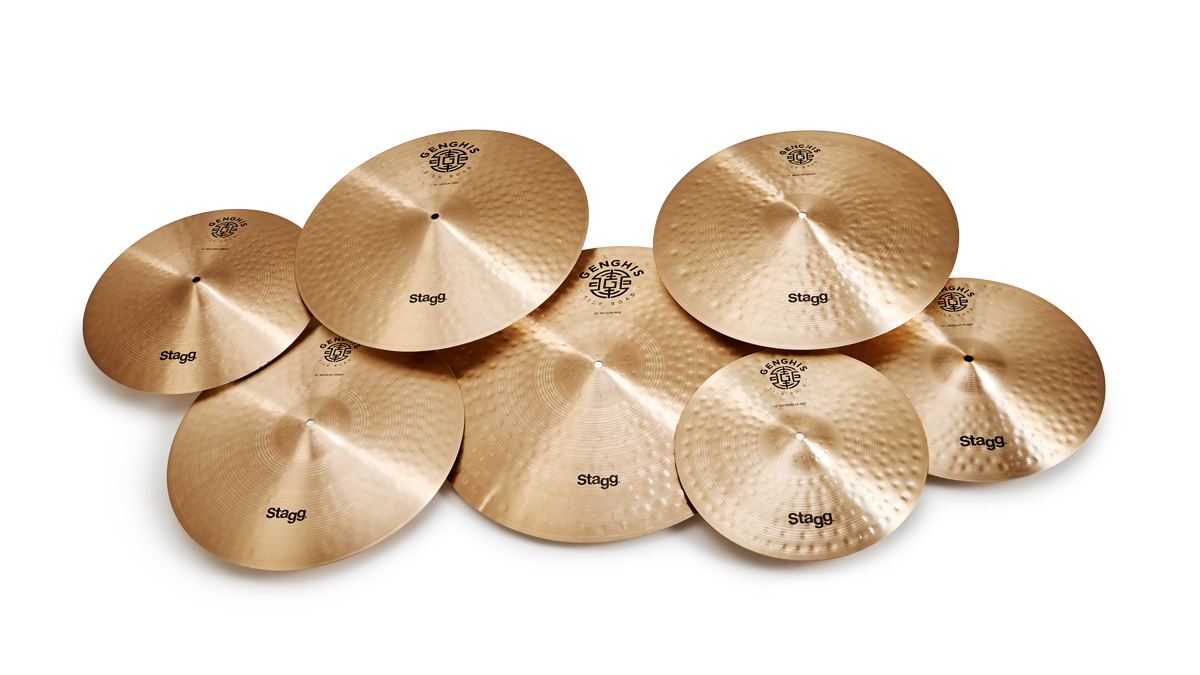MusicRadar Verdict
Stagg’s Genghis is the company’s most complex and sophisticated cymbal line yet.
Pros
- +
Vintage sounds with a modern twist.
Cons
- -
Very few.
MusicRadar's got your back
The ancient trade routes linking China with the west are the subject of much current fascination and research - the so-called Silk Road is a hot topic, no doubt as a result of the rise of China to manufacturing superpower.
The Chinese have been casting beautiful bell-bronze gongs for at least three millennia, way before the Silk Road led to Constantinople and its eventual destiny in modern cymbal craft. Stagg says the Genghis series, “follows the ancient traditions of centuries of bronze finishing and hand-hammered metallurgy, from the depth of Chinese civilisation emerging in the 4th Century AD”.
Stagg’s Eric Tang adds that: “We want to trace back the birth of bronze and the very beginning of this craft-art, as China has an even longer history in making gongs, etc, and this craft travelled all around the world via the Silk Road.”
Build
China-type cymbals were there at the birth of jazz, but it was a long time before Stagg introduced the first made-in-China, Turkish-American style cymbals to the UK market in 1995. As the first B20 bronze cymbals offered at a budget price they caused quite a stir and Stagg has gone on to improve quality and consistency year-on-year. Now with the Genghis series we have serious contenders in the upper echelons of the international cymbal market.
To deliver cymbals of this complexity and excellence requires a lot of effort and Eric Tang explains how producing the Genghis cymbals is the most complicated process the company has undertaken.
“After six or seven times of pressing by the rolling machine - to produce equal thickness - Genghis cymbals go through a double cooling process to lower and stabilise the frequency to reach a deep, dark warm sound with nice sustain and decay.”
The deep hammering is achieved by machine and this is followed by a final tuning, which is carried out via traditional hand hammering. Cymbals are also lathed twice by hand. The result is a deeply cratered, hammered surface with a regular finish, topped off with the striking Genghis logo.
Hands on
Mounting the 20" and 22" rides we are immediately struck by their musicality and complex, ‘grown-up’ ambience. The medium weight is on the thin side and thus the cymbals are naturally dark with a luxuriously soft and warm quality. The ‘tahh’ wash is rich, wide and ever-present. Crash-riding is no problem though.
With the 22" the wash is trashy, enveloping and expressive, where with the 20" it’s more controlled and quicker to die down. There is though also a top-end along with the decisive, clean stick response.
In fact, the 20" has a definite bright, almost tinny top to it and will cut in more rocky settings, making it possibly more modern and versatile. The bells are if anything even more tasteful, with no dead spots. They have a relatively low profile, which integrates them into the body of the cymbals, so they are not detached, but nevertheless ring out with an engagingly pure and deliciously harmonious tone.
With the crashes, the quality again shines through as deft strokes yield tidy and sweet punctuations with no lingering, clanging after-tones. Just a full-on whoosh, with a surprisingly marked separation between each size, so you must choose carefully.
The review crashes start with a bright and breezy, fast and almost splash-like 16", then a big jump in tonality from the still sharp and fast 18" - perhaps the pick of the three - to the rather meatier, mellower 19".
The softness really does play into the vintage vibe of the hi-hats. They are quite papery and as a result, they are not the loudest when played closed with the tip. With some hats if you apply heavy foot pressure to get a really tight closed sound they emit a high-pitched squeak. This does not happen with these, so you can get a taut, brisk tick with no awkward overtones.
They are unlikely to dominate the mix in the way some shriller hats can. Even the bark is polite, not abrasive, more of a hissing steam engine whoosh. That in turn could lead to the accusation they lack colour. But we would suggest that it’s fairer to say they are crisp and efficient.
As with all the cymbals on review here you can be delicate, play with a lighter stick and small bead and pick out the variation of tones and pitches available across the surface. Open them up and the sound remains deep but never harsh, particularly with the larger 15" pair.
“These tariff actions will have a long-term effect on musicians worldwide”: The CEO of NAMM urges Trump to dump tariffs on components of musical instruments
Brace yourself: Bryan Adams didn’t buy his first real six-string in a five and dime
“Nobody listens to one genre. I literally don’t know anybody who listens to one genre. You can be a fan of so many different artists at once”: Laufey on what Gen Z can teach the rest of us about how to appreciate music










